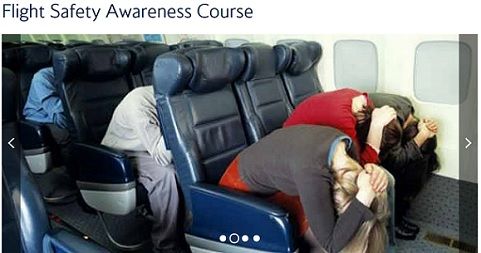Scott Mayerowitz attended the British Airways flight safety awareness course (£162 to attend) and shares the key takeaways for how to survive a plane crash.

It’s all obvious stuff, things we’ve heard a hundred times, but it bears repeating since none of us actually pay attention to the safety video (except when Deltaline used to wag her finger at us).

But since even then, all we saw was that finger wag, here’s what you need to know:
[T]he key to survival is getting into the proper brace position: Bend forward as far as possible, keep your head down. Place your feet flat on the floor and slide them back.
Your dominant hand goes on the back of your head. Protect that hand by placing the other hand over it. Do not interlock fingers. The goal is to ensure that the bones in the stronger hand aren’t broken so you can eventually unbuckle the seatbelt.
…All passengers should think about an emergency during the safety demonstration. Use that time to look for the nearest exit, plus an alternative one. Check where the life vest is and practice unbuckling the seatbelt to build a bit of muscle memory.
There were other safety tidbits dispensed that day. Red lights always signal an exit because the color cuts through smoke the best. Always inflate life vests outside the plane; they can limit mobility in a tight space and if water fills the cabin, passengers with inflated vests can be pressed up against the ceiling, unable to swim down to the door.
I hope none of us never need it! And I always do look at the exits and count rows in case I can’t see. I think I’ve buckled and unbuckled enough to have the muscle memory. But I didn’t really know to put my ‘dominant hand’ underneath the other one. And I probably would have intelocked fingers, so good to know not to do this and the reason why!
- You can join the 40,000+ people who see these deals and analysis every day — sign up to receive posts by email (just one e-mail per day) or subscribe to the RSS feed. It’s free. You can also follow me on Twitter for the latest deals. Don’t miss out!


As Orson Wells once said…”There are only two emotions in a plane: boredom and terror.”
I have been through a flight survival course. One more tip is to find things in the presumed dark and smoke by sweeping with your hand. For example, bring your hand to your chest and sweep down with your arm to find the seatbelt buckle. If your are next to the exit door, touch a known point and sweep up to find the handle. Too bad the course doesn’t involve rotating the airframe upside down and submerging in a pool. I had fun doing that!
I think more thought should be given to this as I do not believe current procedures(staying in your seat in a brace position) ever saved a lives when a plane crashes whether over land or over sea.
What I have seen in small planes is that passengers who jump out before the plane crashes(assuming its at sea)have a greater chance of survival over someone who braces for a crash in his/her seat.
The whole “Bend forward as far as possible, keep your head down” always intrigued me. I understand things are going to fly left and right, but if you bend forward that far, your head is pretty much going to touch the seat in front of you. This seat, in case of crash, is going to shake like crazy, how is it not going to knock you out at best, or crush your skull at worst?
162 pounds? Yikes. Hope they got more information than that. I’ve read a number of useful tips over the years…many deal with the most dangerous parts of the flight, takeoff and landing. One example, keep your shoes on until the plane is at altitude, and likewise make sure they are on prior to landing. So many people board a plane and immediately take their shoes off.
Guys,
Has anyone actually done a study of how many people survive a plane crash following the safety procedures in the video?
What kind of a crash landing was this safety video meant for? e.g. a water landing, a land crash landing, etc.
It would be nice for someone who is technically knowledgaable of this procedure to shed light on the matter.
@Michael Que I would like to know the answer too. Years ago, someone in the industry told me zero was the number of people in a commercial jet who had survived a water landing following these procedures. That was before the landing in the Hudson though…but I too suspect one’s survival as a pax rides on things beyond your control. And they’re sure not gonna admit that if they’re selling an overpriced safety course that most of us wouldn’t listen to for free.
I do believe quite seriously that it is a worthwhile endeavour for the ntsb or some federal agency to look into developing safety devices to outfit in commercial planes for eventualities such as plane crashes.
If fighter jet pilots can eject out of an f-15 when their plane is hit or malfunctions we should be able to replicate this on a commercial jet.
Maybe having a commercial aircraft open its top at the sign of trouble and having passengers strapped to their seats being ejected out in the air with a parachute deploying later on would suffice.
I readily admit its sounds straight out of a sci fi movie but I believe it is worth looking into. Especially if it would save lives.
I also heard your feet should be flat on the floor to prevent breaking your ankles. Many who die after a crash are because their ankles break and they cannot escape the fire.
Mike D’s tip about keeping your shoes on during takeoff and landing bears repeating. If there is a need to evacuate the plane, you won’t have time to hunt for your shoes and there probably will be lots of sharp debris lying about.
Another suggestion, occasionally mentioned during the safety briefing, is to keep exit-row window shades open so you can see the situation outside before opening the exit. If there is thick smoke or flames, you don’t want to pop the hatch and have them enter the cabin.
This reminds me of grade school and the exercise to get under your desk during a nuclear blast….
Count the nuber of seats between you and the exit when you board and try to remember that number. You may have to climb over seats to get out (if it is even upright).
Also, do a similar thing for hotels – count the number of doors to the fire exit in case you have to crawl.
Regarding the brace position, I believe the objective here is to make yourself as small and compact as possible, while keeping your limbs from flailing about and protecting your head. One hand on top of the other can hold in place better than interlocked fingers. Feet all the way back helps to keep your legs in one place.
Step 1: Unbolt seat in front of you, move it forward far enough to even consider this position.
If I assumed this position (in any coach section I’ve been in in the last 10 years) I’d have a broken neck… No crash needed.
Who the heck is going to shell out $200+ for such a course? I can’t imagine they have a waiting list for the sign-ups.
To whoever was asking why the brace position, I am pretty sure the idea is to get you as close to the position your body will end up if there is an impact. That way, the decoration force when you inevitably hit the seat in front of you is as small as possible. If your head flings forward 3-4 feet then hits the seat, you will probably be knocked out. Also, as mentioned, your head is below flying objects that could also knock you out. The key to surviving any plane crash is to be able to get up out of your seat and walk off the plane as soon as you can.
Try chanting the names of God according to your religion. If you die in the crash you’ll end in a place where they don’t need airplanes and there are no crashes. If you’re atheist, try it too. You’ve nothing to lose, and you may be surprised what happens. Try it. You’ll like it.
With all due respect, some of these comments are completely absurd and demand debunking. (I’m a Navy Flight Surgeon, with over 500 flight hours in almost 20 different types of Navy aircraft, a private pilot with over 1500 hours, and an Emergency Physician.)
“What I have seen in small planes is that passengers who jump out before the plane crashes(assuming its at sea)have a greater chance of survival over someone who braces for a crash in his/her seat.” Ridiculous, I’ve never heard or read of anything even close to this. It would be far more dangerous to try and “jump out before the plane crashes” than to pilot or ride the plane to the crash, especially for small planes where a “crash landing’ is often a well-controlled engine out landing. Not to mention the fact that airflow essentially prevents opening the doors of most small airplanes in flight. If your contention is correct, please provide references. BTW, the vast majority of pilots and passengers in small planes do NOT wear parachutes, they are only required in certain specific situations (aerobatics, some experimental planes, etc.). Trying to jump out before the crash makes as much sense as not wearing a seatbelt in a car so you can be thrown clear of the accident, an idea which has been completely disproven. Not wearing a seatbelt might possibly save a life in 1 of 10,000 auto crashes, but it will also cause death or severe injury in the other 9,999 crashes.
“If fighter jet pilots can eject out of an f-15 when their plane is hit or malfunctions we should be able to replicate this on a commercial jet.” Yes, we could replicate this for commercial aircraft if we had about a quarter million dollars per seat, the desire to have hundreds of pounds of explosives on every aircraft, revised aircraft design to allow hundreds of seats to eject through the ceiling and the ability to train every passenger as to how to operate the seat and survive an ejection. Military pilots and aircrew go through many hours of training on ejection seats.
“Maybe having a commercial aircraft open its top at the sign of trouble and having passengers strapped to their seats being ejected out in the air with a parachute deploying later on would suffice.” In addition to the reasons above, image 100-200-300 adjacent ejection seats all being fired at the same time, talk about mid-air collisions. Suggest Googling “why commercial aircraft are not equipped with ejection seats” for more information.
@Michael Que –
“What I have seen in small planes is that passengers who jump out before the plane crashes(assuming its at sea)have a greater chance of survival over someone who braces for a crash in his/her seat.”
Awesome troll job bro.